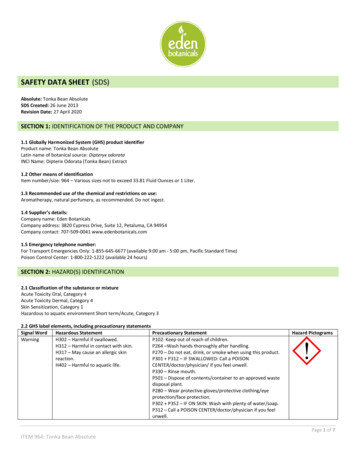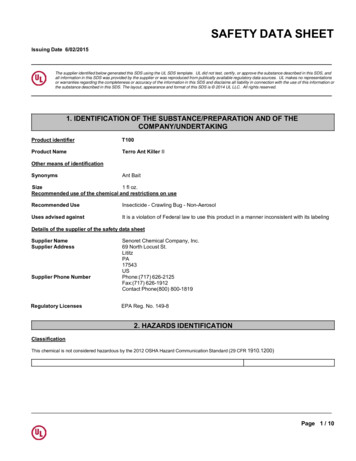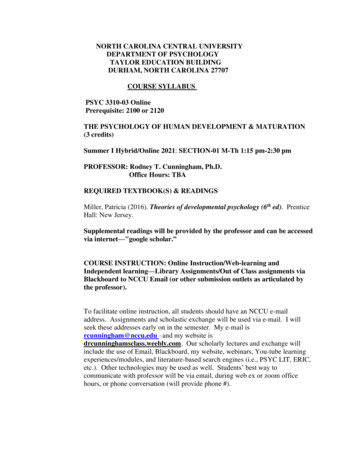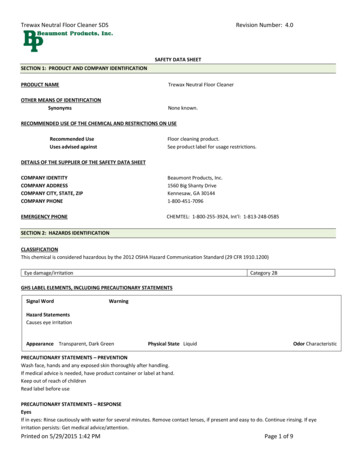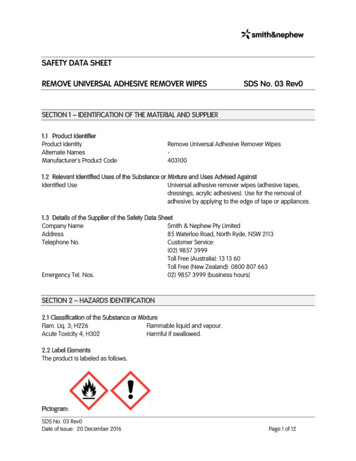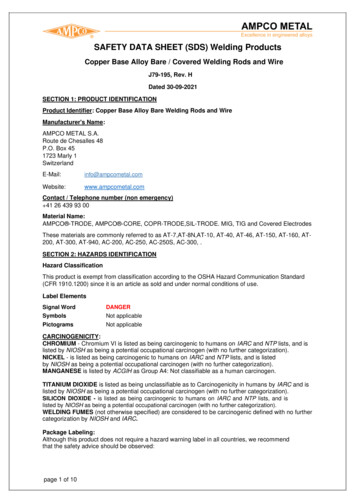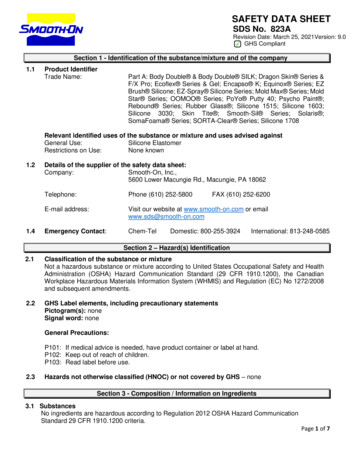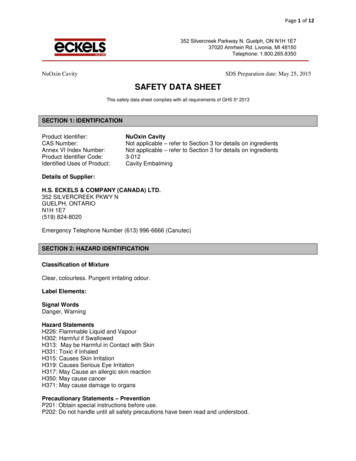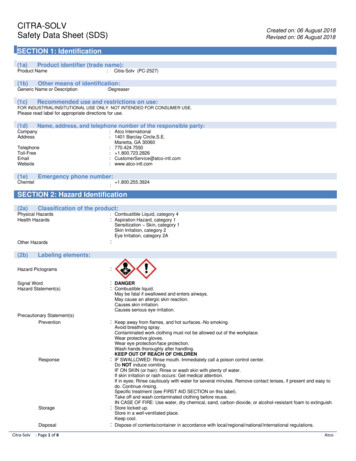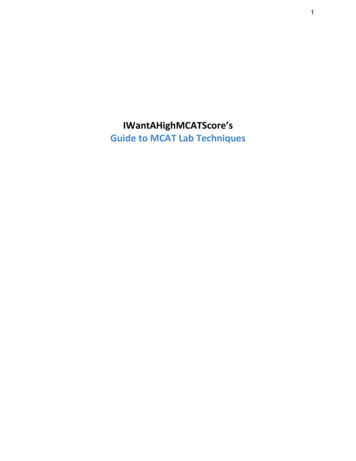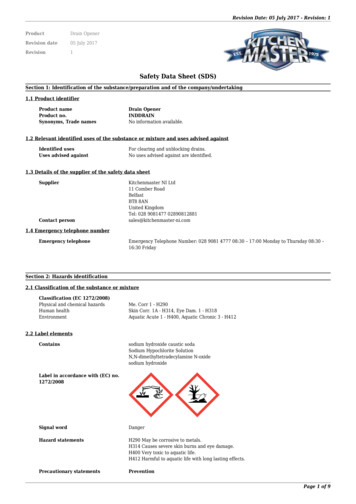
Transcription
Revision Date: 05 July 2017 - Revision: 1ProductDrain OpenerRevision date05 July 2017Revision1Safety Data Sheet (SDS)Section 1: Identification of the substance/preparation and of the company/undertaking1.1 Product identifierProduct nameProduct no.Synonyms, Trade namesDrain OpenerINDDRAINNo information available.1.2 Relevant identified uses of the substance or mixture and uses advised againstIdentified usesUses advised againstFor clearing and unblocking drains.No uses advised against are identified.1.3 Details of the supplier of the safety data sheetSupplierContact personKitchenmaster NI Ltd11 Comber RoadBelfastBT8 8ANUnited KingdomTel: 028 9081477 02890812881sales@kitchenmaster-ni.com1.4 Emergency telephone numberEmergency telephoneEmergency Telephone Number: 028 9081 4777 08:30 – 17:00 Monday to Thursday 08:30 –16:30 FridaySection 2: Hazards identification2.1 Classification of the substance or mixtureClassification (EC 1272/2008)Physical and chemical hazardsHuman healthEnvironmentMe. Corr 1 - H290Skin Corr. 1A - H314, Eye Dam. 1 - H318Aquatic Acute 1 - H400, Aquatic Chronic 3 - H4122.2 Label elementsContainssodium hydroxide caustic sodaSodium Hypochlorite SolutionN,N-dimethyltetradecylamine N-oxidesodium hydroxideLabel in accordance with (EC) no.1272/2008Signal wordDangerHazard statementsH290 May be corrosive to metals.H314 Causes severe skin burns and eye damage.H400 Very toxic to aquatic life.H412 Harmful to aquatic life with long lasting effects.Precautionary statementsPreventionPage 1 of 9
Revision Date: 05 July 2017 - Revision: 1P234 Keep only in original container.P280 Wear protective gloves/ protective clothing/eye protection/face protection.ResponseP301 P330 P331 IF SWALLOWED: Rinse mouth. Do NOT induce vomiting.P303 P361 P353 IF ON SKIN (or hair): Remove/Take off immediately all contaminatedclothing. Rinse skin with water/ shower.P305 P351 P338 IF IN EYES: Rinse cautiously with water for several minutes. Removecontact lenses, if present and easy to do. Continue rinsing.P310 Immediately call a POISON CENTER or doctor/physician.EUH statementsEUH031 Contact with acids liberates toxic gas.2.3 Other hazardsNone known.Section 3: Composition/identification of ingredients3.1 SubstanceNot applicable.3.2 MixturesNameProduct identifierReg. EU 1272/2008CAS-No.: 1310-73-2sodium hydroxide caustic sodaSkin Corr. 1A - H314EC No.: 215-185-5CAS-No.: 7681-52-9EC No.: 231-668-3Skin Corr. 1B - H314, Eye Dam. 1 - H318, STOT SE 3 - H335,Sodium Hypochlorite SolutionREACH Reg No.:Me. Corr 1 - H290, Aquatic Acute 1 - H4001-2119488154-34-xxxxCAS-No.: 3332-27-2Acute Tox 4 - H302, Skin Irrit.2 - H315, Eye Dam. 1 - H318,N,N-dimethyltetradecylamine N-oxideEC No.: 222-059-3Aquatic Acute 1 - H400, Aquatic Chronic 2 - H411CAS-No.: 1310-73-2EC No.: 215-185-5sodium hydroxideSkin Corr. 1A - H314, Eye Dam. 1 - H318, Me. Corr 1 - H290REACH Reg No.:01-2119457892-27-0000Acute Tox 3 - H301, Acute Tox 2 - H310, Skin Corr. 1B CAS-No.: 50-00-0formaldehyde %H314, Skin. Sens 1 - H317, Acute Tox 3 - H331, Muta. 2EC No.: 200-001-8H341, Carc. 1B - H350The full text for all hazard statements are displayed in section 16.Composition comments%10-30%1-10%1-10%1-10%0.001-0.009%The data shown are in accordance with the latest EC Directives. Formaldehye is used in theraw material manufacturing process.Section 4: First aid measures4.1 Description of first aid measuresGeneral informationInhalationIngestionSkin contactEye contactProvide general first aid, rest, warmth and fresh air. As a general rule, in case of doubt or ifsymptoms persist, always call a doctor. Seek medical attention for all burns and eye injuries,regardless how minor they may seem. First aid personnel must be aware of own risk duringrescue.Move the exposed person to fresh air at once. Get medical attention if any discomfortcontinues. If breathing is difficult, provide oxygen. If not breathing, give artificial respirationand get medical attention.Do not induce vomiting. Thoroughly rinse the mouth with water. If vomiting occurs, keephead low so that stomach content doesn't enter the lungs. Never give anything by mouth toan unconscious person. Get medical attention immediately.Remove affected person from source of contamination. Remove contaminated clothing.Immediately flush the affected area with plenty of clean running water for at least fifteen(15) minutes. Seek medical attention immediately.Avoid contaminating unaffected eye. Immediately flush eyes with plenty of water for at least15 minutes, lifting lower and upper eyelids occasionally. Remove contact lenses if presentand easy to do so. Get prompt medical attention.Page 2 of 9
Revision Date: 05 July 2017 - Revision: 14.2 Most important symptoms and effects, both acute and delayedGeneral informationInhalationIngestionSkin contactEye contactThe severity of the symptoms described will vary dependent on the concentration and thelength of exposure.Inhalation of mist and vapour may produce respiratory tract irritation.May cause chemical burns in mouth and throat. May cause severe internal injury.Corrosive. Causes severe skin burns.Causes severe eye damage. Symptoms: Extreme irritation of eyes and mucous membranes,including burning and tearing.4.3 Indication of any immediate medical attention and special treatment neededNotes to the physicianTreat symptomatically.Section 5: Fire-fighting measures5.1 Extinguishing mediaExtinguishing mediaUnsuitable extinguishing mediaUse fire-extinguishing media appropriate for surrounding materials.No unsuitable extinguishing media identified.5.2 Special hazards arising from the substance or mixtureHazardous combustion productsUnusual fire & explosion hazardsSpecific hazardsWhen heated, vapours/gases hazardous to health may be formed.Reacts with metals to liberate hydrogen, which can form explosive mixtures with air.Contact with acids liberates toxic gas. Water used for fire extinguishing, which has been incontact with the product, may be corrosive.5.3 Advice for firefightersSpecial fire fighting proceduresVentilate closed spaces before entering them. If possible, fight fire from protected position.Keep up-wind to avoid fumes. Water spray should be used to cool containers.Protective equipment for firefighters Fire-fighters should wear appropriate protective equipment and self-contained breathingapparatus (SCBA) with a full face-piece operated in positive pressure mode. Clothing for firefighters (including helmets, protective boots and gloves) conforming to European standardEN 469 will provide a basic level of protection for chemical incidents.Section 6: Accidental release measures6.1 Personal precautions, protective equipment and emergency proceduresPersonal precautionsFor emergency respondersWear protective clothing as described in Section 8 of this safety data sheet. Avoid inhalationof vapours and contact with skin and eyes. Evacuate and ventilate area. Eliminate all sourcesof ignition. In case of inadequate ventilation, use respiratory protection. Do not touch or walkthrough spilled material.Follow safe handling advice and personal protective equipment recommendations for normaluse of product.6.2 Environmental precautionsEnvironmental precautionsPrevent further leakage or spillage if safe to do so. Discharge into the environment must beavoided. Spillages or uncontrolled discharges into watercourses must be reportedimmediately to the Local Authority or other appropriate regulatory body.6.3 Methods and material for containment and cleaning upSpill clean up methodsDO NOT touch spilled material! Stop leak if possible without risk. Eliminate all ignitionsources. Ventilate and evacuate the area. Cover drains. Absorb spillage with noncombustible, absorbent material - sand.Use non - metallic tools/containers for clean up. In case of a large scale of spill, dyke areawith sand to stop the spill spreading. Floors may become slippery, avoid falls. Place wastematerial into suitable labelled sealed containers for disposal.6.4 Reference to other sectionsReference to other sectionsSee section 1 for emergency contact. For personal protection, see section 8. For wastedisposal, see section 13.Page 3 of 9
Revision Date: 05 July 2017 - Revision: 1Section 7: Handling and storage7.1 Precautions for safe handlingHandlingUse proper personal protection when handling (refer to Section 8). Avoid spilling, skin andeye contact. Avoid inhalation of vapours. Read and follow manufacturer's recommendations.Keep away from heat, sparks and open flame. Do not mix with other chemicals.When using, do not eat, drink or smoke. Wash thoroughly after handling. Do not wearcontact lenses. Avoid contact with incompatible substances: See section 10. To dilute, alwayspour the product carefully into water – never pour water into product.7.2 Conditions for safe storage, including any incompatibilitiesStorage precautionsStorage classKeep upright, locked up and out of reach of children. Keep away from heat, sparks and openflame. Store in tightly closed original container in a dry, cool and well-ventilated place. Keepaway from oxidizing agents and acids. Avoid contact with metals.Corrosive storage.7.3 Specific end use(s)Specific end use(s)Usage descriptionThe identified uses for this product are detailed in Section 1.2.Use only according to directions. Replace and tighten cap after use.Section 8: Exposure controls/Personal protection8.1 Control parametersComponentsodium hydroxide caustic sodasodium hydroxide caustic sodasodium hydroxidesodium hydroxideformaldehyde %formaldehyde %Ingredient commentsSTDOELWELOELWELOELWELTWA (8 Hrs)0.2 ppm2 ppm2,5 mg/m3STEL (15mins)2 mg/m32 mg/m32 mg/m32 mg/m30.4 ppm2 ppm2,5 mg/m3NotesWEL - Workplace Exposure Limits - EH40/2005 Workplace exposure limits.OEL - Occulational Exposure Limit - Ireland, Occupational Exposure Limits 2016.8.2 Exposure ControlsProtective equipmentEngineering measuresRespiratory equipmentHand protectionProvide adequate ventilation, including appropriate local extraction, to ensure that thedefined occupational exposure limit is not exceeded.Use respiratory protection as specified by an industrial hygienist or other qualifiedprofessional if concentrations exceed the limits listed in Section 8. Respirator selection mustbe based on known or anticipated exposure levels, the hazards of the product and the safeworking limits of the selected respirator. Use respirators and components tested andapproved under appropriate government standards such as CEN (EU).If the respirator is the sole means of protection, use a full-face supplied air respirator. Whererisk assessment shows air-purifying respirators are appropriate use a full-face respiratorwith multipurpose/combination (vapour/particulate) respirator cartridges as a backup toengineering controls. ABEK-P2 (EN 143). Consult manufacturer for specific advice.Where hand contact with the product may occur use gloves approved to relevant standards(e.g. Europe: EN374.) EU Directive 89/686/EEC. Selection of the glove material depends onconsideration of the penetration times, rates of diffusion and degradation, and concentrationspecific to the workplace. Gloves must be inspected prior to use.Suggested material: Nitrile rubber. Minimum layer thickness: 0.4mm. Breakthrough time: 480 minutes. Consult manufacturer for specific advice. Use proper glove removal technique(without touching glove's outer surface) to avoid skin contact with this product.Page 4 of 9
Revision Date: 05 July 2017 - Revision: 1Eye protectionOther protectionHygiene measuresProcess conditionsWear safety goggles/face shield to prevent any possibility of eye contact. Use equipment foreye protection tested and approved under appropriate government standards such as EN166(EU).Personal protective equipment for the body should be selected based on the task beingperformed and the risks involved and should be approved by a specialist. The selectedclothing must satisfy the European norm standard EN 943.DO NOT SMOKE IN WORK AREA! Wash hands at the end of each work shift and beforeeating, smoking and using the toilet. Wash promptly if skin becomes wet or contaminated.Promptly remove any clothing that becomes contaminated.Ensure that eye flushing systems and safety showers are located close by in the work place.Section 9: Physical and chemical properties9.1 Information on basic physical and chemical propertiesAppearanceColourOdourHighly viscous liquid.Milky white.No information available.Odour threshold - lowerNo information available.Odour threshold - upperNo information available.pH-Value, Conc. Solution14.00pH-Value, Diluted solutionNo information available.Melting pointNo information available.Initial boiling point and boilingrangeNo information available.Flash pointNo information available.Evaporation rateNo information available.Flammability stateNo information available.Flammability limit - lower(%)No information available.Flammability limit - upper(%)No information available.Vapour pressureNo information available.Vapour density (air 1)No information available.Relative density1.002kg/m3 @ 20.00 CBulk densityNo information available.SolubilitySoluble in water.Decomposition temperatureNo information available.Partition coefficient; nOctanol/WaterNo information available.Auto ignition temperature ( C)No information available.ViscosityNo information available.Explosive propertiesNot classified as explosive.Oxidising propertiesNo information available.9.2 Other informationMolecular weightNo information available.Volatile organic compoundNo information available.Page 5 of 9
Revision Date: 05 July 2017 - Revision: 1Other informationNone noted.Section 10: Stability and reactivity10.1 ReactivityReactivityReaction with acids and strong oxidising agents. May react with active metals, such asaluminum and iron, to release flammable hydrogen gas. May decompose violently on mixingwith acids, with rapid evolution of chlorine gas.10.2 Chemical stabilityStabilityStable under normal temperature conditions and recommended use.10.3 Possibility of hazardous reactionsHazardous reactionsHazardous polymerisationPolymerisation descriptionContact with acids liberates toxic gas. Attacks metals liberating flammable Hydrogen gas.Not relevant.No information available.10.4 Conditions to AvoidConditions to avoidHeat, sparks, open flames, temperature extremes and direct sunlight. Avoid storing in largequantities or for long periods of time.10.5 Incompatible materialsMaterials to avoidKeep away from acids and oxidants. Avoid contact with iron, stainless steel, copper andcopper alloys, aluminium. Do not mix with other chemicals unless listed on directions.10.6 Hazardous decomposition productsHazardous decomposition productsIf heated, harmful vapours may be formed. Chlorine, hypochlorous acid, sodium chlorate.Chlorine compounds. Carbon oxides.Section 11: Toxicological information11.1 Information on toxicological effectsToxicological informationNo toxicological information for the overall finished product.Acute toxicity (Oral LD50)SODIUM HYDROXIDE (CAS: 1310-73-2):500 mg/kg Rat. (IUCLID chemical data sheet.)FORMALDEHYDE (CAS: 50-00-0): 800 mg/kg bw Rat. REACH dossier information. SODIUMHYPOCHLORITE SOLUTION (CAS: 7681-52-9): 1100 mg/kg, Rat. REACH dossierinformation.SODIUM HYDROXIDE (CAS: 1310-73-2):1350 mg/kg Rabbit. (IUCLID chemical data sheet).SODIUM HYPOCHLORITE SOLUTION (CAS: 7681-52-9): 20000 mg/kg, Rabbit. REACHdossier information.FORMALDEHYDE (CAS: 50-00-0): RD50 of 38 mg/m³ Rat. REACH dossier information.SODIUM HYPOCHLORITE SOLUTION (CAS: 7681-52-9): 10.5 mg/l (vapours, Rat, 1 hour.)REACH dossier information.Acute toxicity (Dermal LD50)Acute toxicity (Inhalation LD50)Serious eye damage/irritationCauses serious eye damage.Skin corrosion/irritationThe product is classified as a skin corrosion/irritation hazard.Respiratory sensitisationSkin sensitisationNo information available.No information available.Germ cell mutagenicityNo information available.CarcinogenicityNo information available.Specific target organ toxicity - Single exposure:STOT - Single exposureNo information available.Specific target organ toxicity - Repeated exposure:STOT - Repeated exposureNo information available.Page 6 of 9
Revision Date: 05 July 2017 - Revision: 1InhalationIngestionSkin contactEye contactWaste managementInhalation of mist and vapour may produce respiratory tract irritation.May cause chemical burns in mouth and throat. May cause severe internal injury.Corrosive. Causes severe skin burns.Causes severe eye damage. Symptoms: Extreme irritation of eyes and mucous membranes,including burning and tearing.When handling waste, consideration should be made to the safety precautions applying tohandling of the product.Routes of entryTarget organsNo information available.Eyes, skin, digestive system, respiratory system.Aspiration hazards:Reproductive toxicity:No information available.No information available.NameN,N-dimethyltetradecylamine N-oxideLD50 oral 2000.00mg/kg RatLD50 dermalLD50 inhalationSection 12: Ecological information12.1 ToxicityAcute toxicity - FishSODIUM HYDROXIDE (CAS: 1310-73-2)LC50: 45.4 mg/l Onchorhynchus mykiss (Rainbowtrout), 96 hours. IUCLID chemical data sheet. FORMALDEHYDE (CAS: 50-00-0) LC50: 6.7mg/L Morone saxatilis (striped bass), 96 hours. REACH dossier information. SODIUMHYPOCHLORITE SOLUTION (CAS: 7681-52-9): LC50 (96 hours) .023 mg/l, Pink salmon.REACH dossier information.Acute toxicity - Aquatic invertebrates SODIUM HYDROXIDE (CAS: 1310-73-2) EC50: 40.4 ug/L Ceriodaphnia sp, 48 hours. REACHdossier information. FORMALDEHYDE (CAS: 50-00-0): 1.9 mg/L Daphnia pulex, 48 hours.REACH dossier information. SODIUM HYPOCHLORITE SOLUTION (CAS: 7681-52-9): EC50(48 hours) 35 ug/L, Ceriodaphnia dubia. NOEC (48 hours) 25 ug/L, Ceriodaphnia dubia.REACH dossier information.Acute toxicity - Aquatic plantsFORMALDEHYDE (CAS: 50-00-0) EC50: 03.48 mg/L Desmodesmus subspicatus (reported asScenedesmus subspicatus), 72 hours. REACH dossier information. SODIUM HYPOCHLORITESOLUTION (CAS: 7681-52-9): EC50 (96 hours) 0.01 mg/l, Myriophyllum spicatum. NOEC(96 hours) 0.02 mg/l, Myriophyllum spicatum. REACH dossier information.Acute toxicity - MicroorganismsNo information available.Chronic toxicity - FishNo information available.Chronic toxicity - AquaticNo information available.invertebratesChronic toxicity - Aquatic plantsNo information available.Chronic toxicity - MicroorganismsNo information available.EcotoxicityThe product contains substance which is very toxic to aquatic life. The product contains asubstance which is harmful to aquatic life with long lasting effects.Eco toxilogical informationNo ecological toxicity available on the overall finished product.12.2 Persistence and degradabilityDegradabilityBiological oxygen demandChemical oxygen demandThe degradability of the product has not been stated.No information available.No information available.12.3 Bioaccumulative potentialBioaccumulative potentialBioacculmation factorPartition coefficient; nOctanol/WaterNo data available on bioaccumulation.No information available.No information available.12.4 Mobility in soilMobilitySoluble in water.12.5 Results of PBT and vPvB assessmentResults of PBT and vPvB assessment The product does not contain any PBT or vPvB Substances.Page 7 of 9
Revision Date: 05 July 2017 - Revision: 112.6 Other adverse effectsOther adverse effectsNone known.NameAcute toxicity (Fish)N,N-dimethyltetradecylamine N-oxideLC50 96 Hours 5.00mg/l FreshwaterFishAcute toxicity (Aquaticinvertebrates)Acute toxicity(Aquatic plants)Section 13: Disposal considerationsWaste managementWhen handling waste, consideration should be made to the safety precautions applying tohandling of the product.13.1 Waste treatment methodsDisposal methodsDispose of waste and residues in accordance with local authority requirements. For wastedisposal, use a licensed industrial waste disposal agent.Section 14: Transport information14.1 UN numberUN no. (ADR)UN no. (IMDG)UN no. (IATA)UN1760UN1760UN176014.2 UN proper shipping nameADR proper shipping nameIMDG proper shipping nameIATA proper shipping nameCORROSIVE LIQUID, N.O.S. (sodium hydroxide caustic soda Sodium HypochloriteSolution)CORROSIVE LIQUID, N.O.S. (sodium hydroxide caustic soda Sodium HypochloriteSolution)CORROSIVE LIQUID N.O.S. (sodium hydroxide caustic soda Sodium HypochloriteSolution)14.3 Transport hazard class(es)ADR classIMDG classIATA class888Transport labels14.4 Packing groupADR/RID/ADN packing groupIMDG packing groupIATA packing groupIIIIII14.5 Environmental hazardsADRIMDGIATAYesYesYes14.6 Special precautions for userEMSEmergency action codeHazard no. (ADR)Tunnel restriction codeF-A, S-BA380(E)Page 8 of 9
Revision Date: 05 July 2017 - Revision: 114.7 Transport in bulk according to annex II of MARPOL73/78 and the IBC codeNot applicable.Section 15: Regulatory information15.1 Safety, health and environmental regulations/Legislation specific for the substance or mixtureEU legislationRegulation (EC) No 1272/2008 of the European Parliament and of the Council of 16December 2008 on classification, labelling and packaging of substances and mixtures,amending and repealing Directives 67/548/EEC and 1999/45/EC, and amending Regulation(EC) No 1907/2006 with amendments. The UN Globally Harmonized System (GHS) SafetyData Sheet format (Annex IV) is implemented as Annex II of REACH EU No 453/2010 of 20thMay 2010 amending regulation (EC) No 1907/2006.Approved code of practice2016 Code of Practice for the Chemical Agents Regulations in accordance with section 60 ofthe Safety, Health and Welfare at Work Act 2005 (No. 10 of 2005).Workplace Exposure Limits Guidance Note EH40/2005.Chemical safety assessmentNo chemical safety assessment has been carried out.Section 16: Other informationGeneral informationRevision commentsRevision dateRevisionSafety data sheet statusThis Safety Data Sheet is in accordance with Reach Regulation (EC) No 453/2010.This is a first issue.05 July 20171Approved.Hazard statements in 17H331H341H350EUH031H412Causes severe skin burns and eye damage.May be corrosive to metals.Causes serious eye damage.May cause respiratory irritation.Very toxic to aquatic life.Harmful if swallowed.Causes skin irritation.Toxic to aquatic life with long lasting effects.Causes serious eye irritation.Toxic if swallowed.Toxic in contact with skin.May cause an allergic skin reaction.Toxic if inhaled.Suspected of causing genetic defects .May cause cancer .Contact with acids liberates toxic gas.Harmful to aquatic life with long lasting effects.DisclaimerThis information relates only to the specific material designated and may not be valid for such material used in combination with anyother materials or in any process. Such information is, to the best of the company's knowledge and belief, accurate and reliable as ofthe date indicated. However, no warranty guarantee or representation is made to its accuracy, reliability or completeness. It is theuser's responsibility to satisfy himself as to the suitability of such information for his own particular use.End of Safety Data Sheet
Product name Drain Opener Product no. INDDRAIN Synonyms, Trade names No information available. 1.2 Relevant identified uses of the substance or mixture and uses advised against Identified uses For clearing and unblocking drains. Uses advised against No uses advised against are identified. 1.3 Details of the supplier of the safety data sheet
